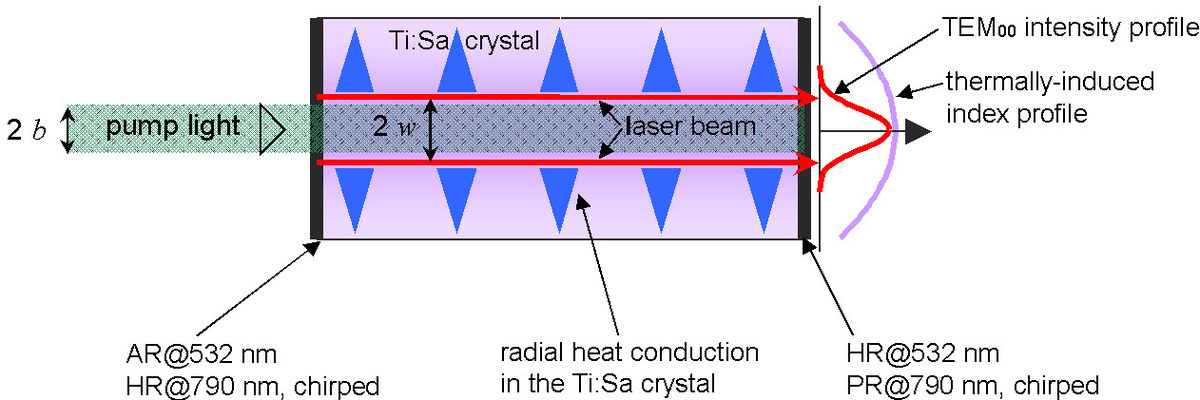The goal of this project is to investigate a new type of mode-locked Titanium-doped Sapphire ("Ti:Sa") laser. This will be the first monolithic Ti:Sa laser and the first mode-locked solid state laser to have a repetition rate in the range of 30 GHz up to 300 GHz. The unusual large gain bandwidth of Ti:Sa supports a large number of longitudinal modes despite the resonators having to be short. This leads to background-free ultra-short pulses at unprecedented repetition rates. As a first step, we recently achieved mode-locking at a reptition rate of 17 GHz with 204 fs pulses. To the best of our knowledge, this is the highest repetition rate of any mode-locked Ti:Sa laser. Mode-locking is stable and always self-starting. We now want to scale the repetition rate to 30 GHz and beyond.
The laser is a simple, Ti:Sa disk with a thickness between 0.3 mm and 5 mm that bears dispersion-compensating coatings on both sides. Our calculations show that it is possible to achieve Kerr-Lens mode-locking in such a simple structure. We want to investigate the mode-locking conditions and the noise properties of this new type of Ti:Sa laser. The monolithic setup has the advantage that there are no anti-reflective coatings inside the resonator. This prevents etalon effects and reduces losses. The short Ti:Sa crystals allows dispersion compensation using just the coatings on the two surfaces of the crystal, making quasi-soliton mode-locking possible. The pulse repetition rate will be very constant, i. e. pulse timing jitter will be low, because there can be no vibration of resonator mirrors or air turbulence inside the resonator. This inherent stability of monolithic laser systems is known from monolithic single frequency lasers.

A mode-locked laser with stable fs-pulses at tens of GHz or hundreds of GHz repetition rate will have applications for dual-comb spectroscopy, astro-combs, ultrafast pulse shaping, optical communication, or frequency metrology. The high repetition rate allows separating the modes with a dispersive system of moderate resolution. This leads to compact and cost-effective systems for frequency comb applications. Despite the high repetition rate, the peak power of such a laser will still be several tens or thousands times higher than its average power, meaning that hundreds of Watts or even a Kilowatt can be expected. This will set this Ti:Sa laser apart from mode-locked semiconductor lasers which have reached 100 GHz repetition rate albeit with a peak power of less than 2 W. A high peak power means that nonlinear optical processes can be driven which is beneficial for pulse characterization and for applications.
With future advances in output power and beam quality of blue and green diode lasers it should be possible to pump this Ti:Sa laser directly with a diode laser. This would yield a very compact and rugged femtosecond laser and frequency comb.
The project is funded by the DFG (Deutsche Forschungsgemeinschaft).


